Eye-Opening Work-Life Balance Statistics [2024]
Posted by Rob Errera on 08/24/2023
![Eye-Opening Work-Life Balance Statistics [2023]](https://cdn11.bigcommerce.com/s-dnybxc6/images/stencil/750x500/uploaded_images/worklife-balance-statistics.jpg?t=1627415383)
At a Glance: Work-Life Balance Stats
- Prioritizing work-life balance brings positive outcomes, including 25% lower turnover and 50% reduced healthcare costs for companies.
- However, despite these efforts, burnout continues to be a significant issue, with a notable 42% increase in reported cases globally in 2022 compared to the previous year.
- In the US, burnout rates are now at 45%, attributed to factors like workload, staff shortages, and work-life balance concerns.
- Globally, New Zealand leads on the 2023 Global Life-Work Balance Index with a score of 79.35, followed closely by Spain and France.
- Gartner predicts a shift toward remote work. By 2025, about 35% of the global workforce will work remotely, up from 17% in 2019.
- Remote work led to improved work-life balance for 67% of US individuals. 78% indicated they wanted to continue remote work even after the pandemic.
With the pandemic, there have been significant changes to the traditional concept of work-life balance in recent years. When much of the workforce began working from home during the pandemic, it became harder than ever to separate job responsibilities and family duties.
Especially, the new generation found it difficult to manage a good balance between their private and work life.
When do you stop working if you never leave the “home office” and never punch out?
Returning to the office after a long break presents its own challenges. How do you re-establish a healthy work-life balance? How have your personal priorities changed post-pandemic?
Let’s see what the most recent numbers say about work-life balance.
Benefits of Work-Life Balance in Numbers
Creating an environment that promotes a healthy work-life balance not only benefits employees but also yields significant advantages for companies.
We can see this through the following numbers.
- Companies that offer a good work-life balance have 25% less employee turnover.
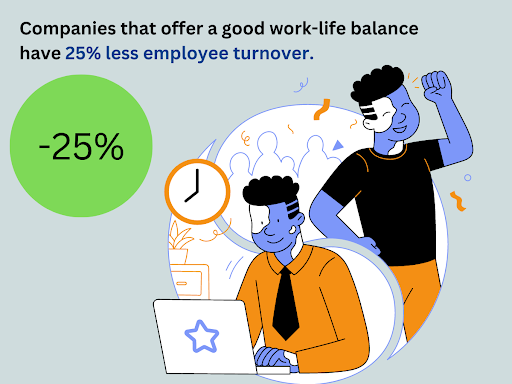
- Similarly, companies with good work-life balance programs have 50% fewer healthcare costs.
- 85% of companies that offer work-life balance programs for their employees report an increase in productivity.
- 33% of employees who have a good work-life balance say they plan to stay in their current jobs.
- Workers with a strong work-life balance show 21% higher productivity.
- Even working from home for just one day a month results in 24% of individuals feeling happier and more productive.
- Offering remote work programs could lead to a 13% productivity increase for your business.
Employee Burnout Stats
A 2023 survey by Future Forum, involving 10,243 workers from 6 countries, reveals that a notable portion of the workforce reported experiencing burnout in 2022.
- 42% of the workforce globally is reporting burnout in November 2022, indicating a slight rise of 4% from May 2021.
- Australia has the highest burnout rate at 50%, with France and the UK following closely with burnout rates of 48%.
Percentage of Global Workplace Burnout, by Country (Nov 2022)
- Workers in companies considered technology laggards are more likely to feel burned out compared to those in innovative companies.
- People who are burned out are almost 3.4 times more likely to switch jobs within the next year compared to those not facing burnout.
- Burnout occurrences are linked to age and gender as well. 46% of women report being burned out, while this figure stands at 37% for men.
- 48% of workers under 30 feel burned out compared to 40% of workers aged 30 and above.
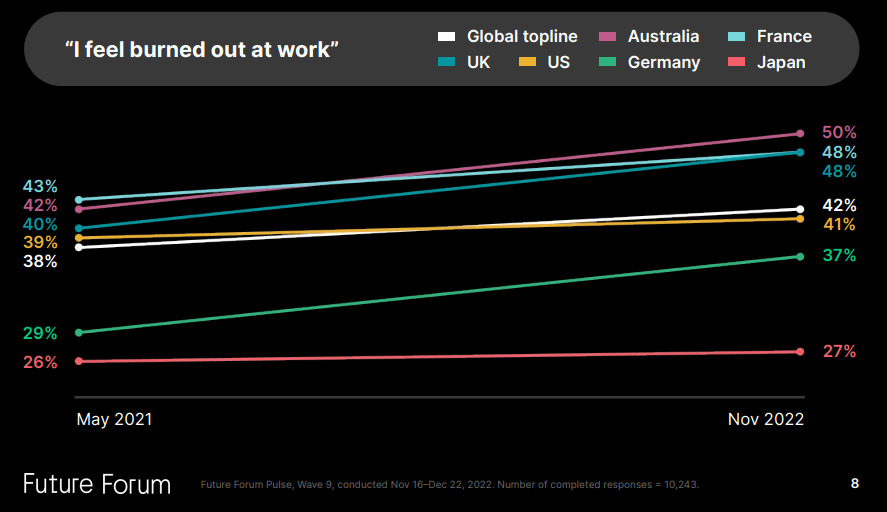
Employee Burnout in the US
Americans are stressed at work. Around half of the workforce feels it needs help with stress management and one-quarter of employees say they’re approaching job burnout.
- An August 2023 survey by Eagle Hill Consulting reveals that 45% of Americans currently experience burnout, which is a decrease from 58% in 2020.
- The primary causes of burnout include workload at 51%, staff shortages at 45%, and work-life balance at 42%.
- 56% of employee burnout is caused by a negative work culture and is to blame for 20-50% of turnover.
Top 5 Causes of US Employees Burnout at Work
- Breaking down the data by generation, millennials top the chart with a burnout rate of 52%.
- Among genders, women report a burnout rate of 48%, while men report a burnout rate of 41%. According to another research, 56% of employee burnout is caused by a negative work culture and is to blame for 20-50% of turnover.
- 95% of human resources professionals blamed the loss of good employees on job burnout.
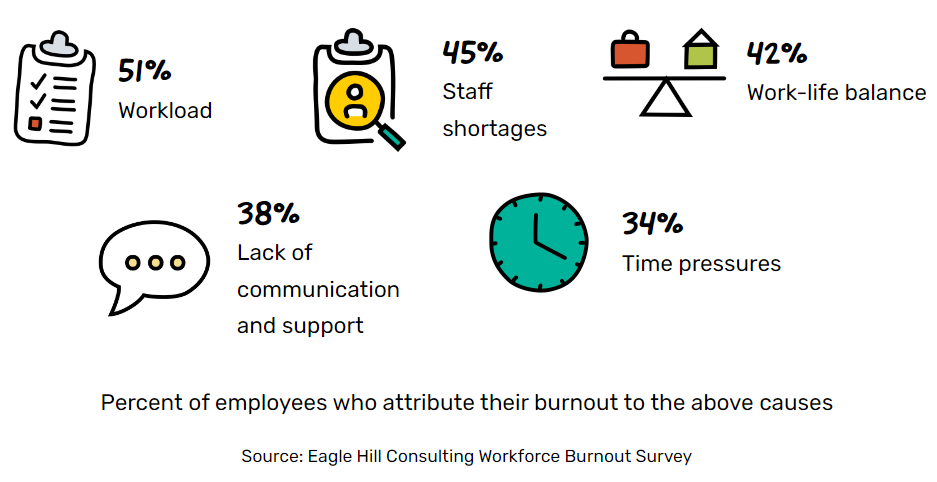
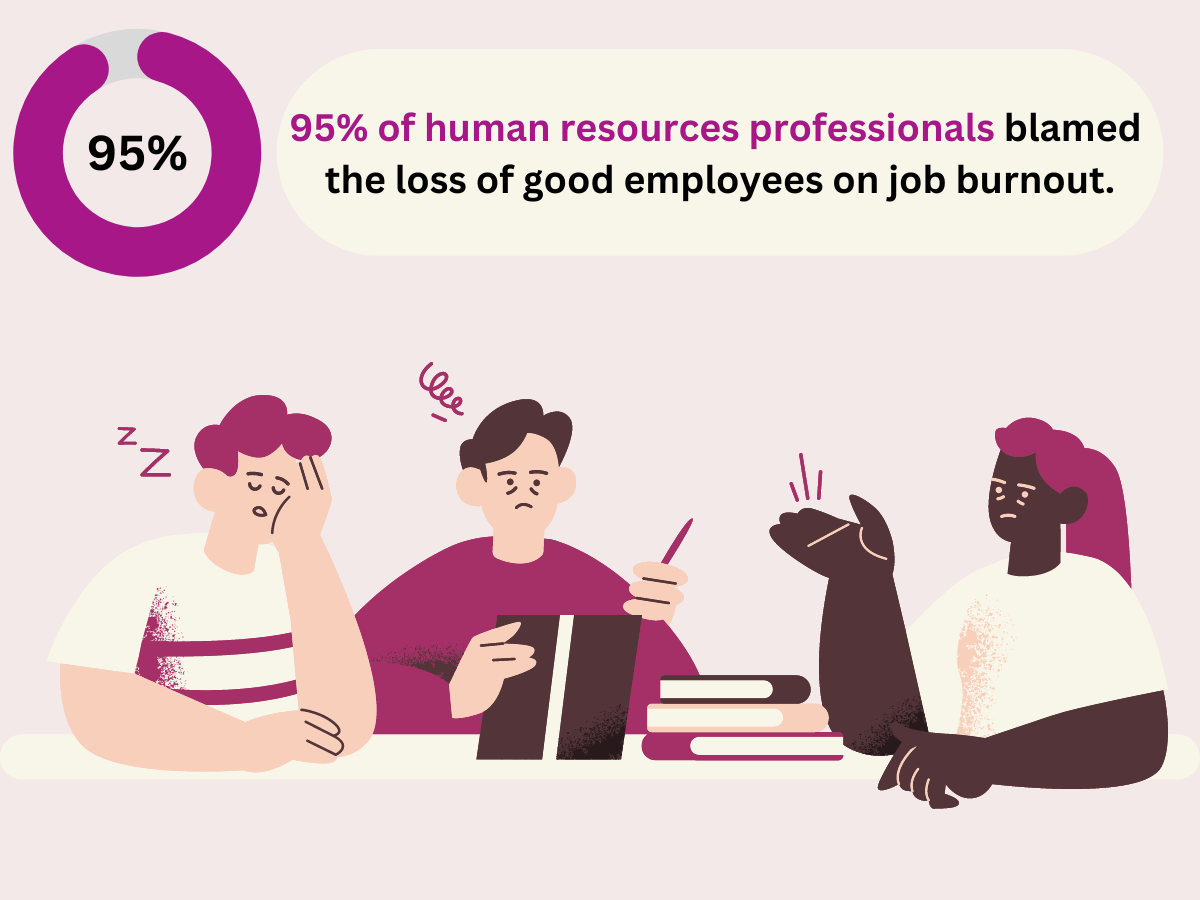
- 16% of HR leaders say a lack of budget is the primary obstacle to improving employee retention in the next 12 months.
- 46% of HR leaders say burnout is behind up to half (20-50%) of their annual employee turnover.
- 14% of HR leaders say lack of executive support is an additional obstacle to improving retention in 2017; 13% cite a lack of organizational vision.
- 41% of burnout is caused by unfair pay, 32% is caused by unreasonable workload and 32% is caused by too much overtime.
- 87% of employers believe improving retention to be a critical priority in their organizations over the next five years.
- 39% of workers cite work-life balance as an important aspect of their jobs.
- 51% of workers say they have missed important life events because of work commitments.
- 11% of employees feel they are overworked.
- Around 48% of employed Americans feel mentally and physically exhausted after their workday.
- 26% of salaried employees say they work outside business hours.
- Generally, 43% of the workforce is made up of remote workers in some capacity.
- 70% of employees will read their emails while watching television at home.
- 67% of people say their work-life balance improved once they began working remotely.
- 97% say a job with flexibility has a major positive impact on overall happiness.
Jobs with the Highest Burnout Rate
Burnout is a prevalent issue across various job sectors, industries, and companies worldwide.
- According to Statista, the hotel, food services, and hospitality industry had the highest burnout rate globally in 2019, with about 80% feeling overwhelmed by their workload.
- Both the manufacturing sector and the medical and healthcare industries experienced a burnout rate of over 76%.
- In 2022, primary care physicians in selected countries were surveyed for their burnout rates. Over half of the surveyed doctors reported stress without feelings of burnout.
- In countries like Australia, the Netherlands, Germany, Switzerland, the United Kingdom, and the United States, less than 5% of doctors felt completely burned out.
- However, Canadian doctors reported a significant burnout rate of over 18%, and the same percentage was observed among doctors in New Zealand.
- Conversely, Swiss physicians appeared to experience the least burnout among the surveyed countries in 2022.
- According to Medscape's 2023 report, which surveyed over 9,100 physicians in the US, 53% of physicians reported experiencing burnout in 2022. The specialty with the highest burnout rate was emergency medicine, at 65%.
- In 2023, registered nurses in the United States exhibited alarming levels of burnout.
- More than two-thirds of surveyed registered nurses reported feeling burnout on most days.
- Of these nurses, 37% strongly agreed and 31% somewhat agreed with experiencing burnout on most days.
- Only 8% of nurses strongly disagreed with feeling burned out during their job on most days.
- "The State of Burnout 2020" report by Blind, which surveyed 3,921 users, highlighted the most burned out companies. Oberlo ranked first with a burnout rate of 78.6%, followed by T-Mobile and Apple.
Industries With the Highest Employee Burnout Rate Worldwide in 2019
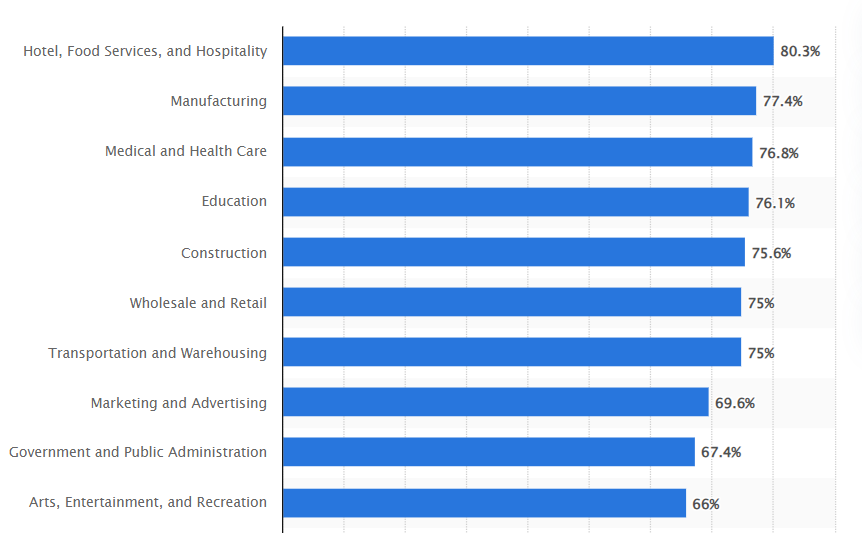
Source: Statista
The 10 Most Burned Out Companies in 2020
- According to another research, the following positions are among those with the highest burnout rates: physician, nurse, retail worker, social worker, and police officer.
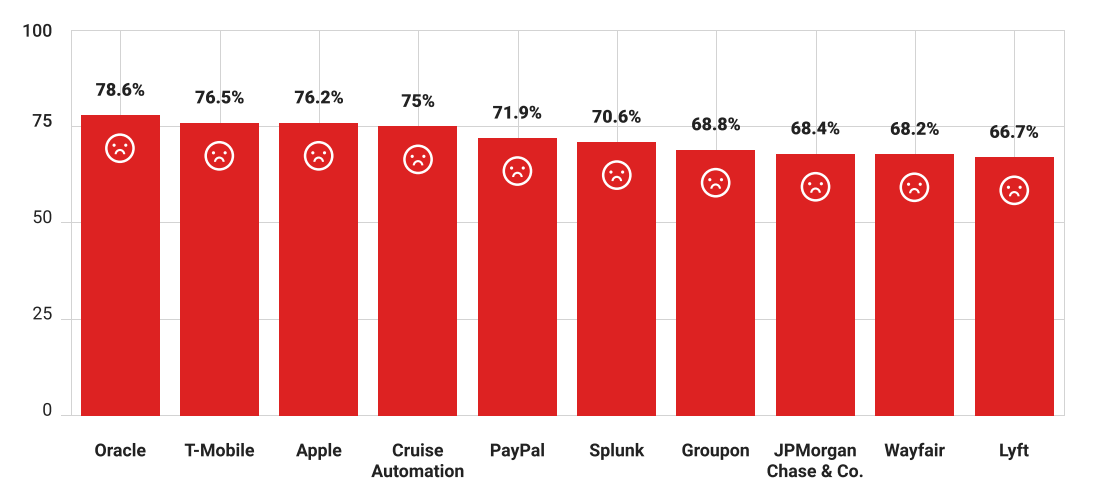 Source: "The State of Burnout 2020" report by Blind
Source: "The State of Burnout 2020" report by Blind
Top Large US Companies to Work for in 2023
According to Glassdoor study, the following companies earned high marks for flexible work environments, enhanced benefits packages, and a strong emphasis on work-life balance. (Scores from 0-to-5.)
- Gainsight - 4.7
- Box - 4.6
- Bain & Company - 4.6
- McKinsey & Company - 4.6
- NVIDIA - 4.6
- MathWorks - 4.6
- Boston Consulting Group - 4.6
- Google - 4.6
- ServiceNow - 4.6
- In-N-Out Burger -4.6
Employee Working Hours & Leisure Time Statistics
- According to EY, half of the workers are working more than 40 hours per week (survey results of 9700 employees).
- The average worker around the world spends roughly 63% of their day, or 15 hours, on sleep and leisure time.
- The average worker in the United States spends only 60% of their day, or 14.4 hours, on sleep and leisure activities.
- Men and women spend an equal amount of leisure time.
- 67% of men (compared to 57% of women) have changed their jobs to better manage work and family lives.
- According to the same research, some of the top reasons why employees leave their jobs are minimal wage growth and a workplace that doesn’t allow for flexibility.
- Working flexibly and without penalty ranked the third-highest priority (after pay and benefits) for millennials around the world.
- About one-third of professionals reported that today it is harder to achieve work-life balance than ever before.
- It was found that working parents are among those who have the hardest time managing work and home life.
- The older groups of millennials (40+ years old) generally put a higher value on paid parental leave than previous generations.
Working Hours & Leisure Time in the US
- The typical American worker logs 34.3 hours per week.
- Those in US mining or logging jobs work an average of 44.8 hours per week.
Average Weekly Work Hours in the US, by Industry (As of July 2023)
- American employees log 3.9 billion hours per month.
- According to EY, "Finding time for me" was the most prevalent challenge faced by US millennial parents who were managers, followed by "getting enough sleep" and "managing personal and professional life".
- According to the same research, millennials are almost twice as likely to have a spouse or partner working full-time than Baby Boomers (78% vs. 47%).
- 83% of US millennials said they'd be more likely to join the company that offered paternity leave, and 38% said they'd leave the United States for another country to get this benefit.
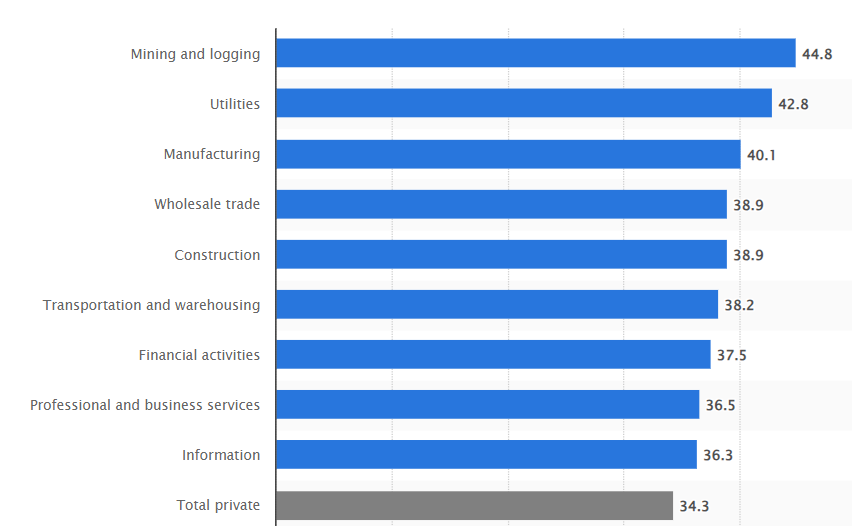
Source: Statista
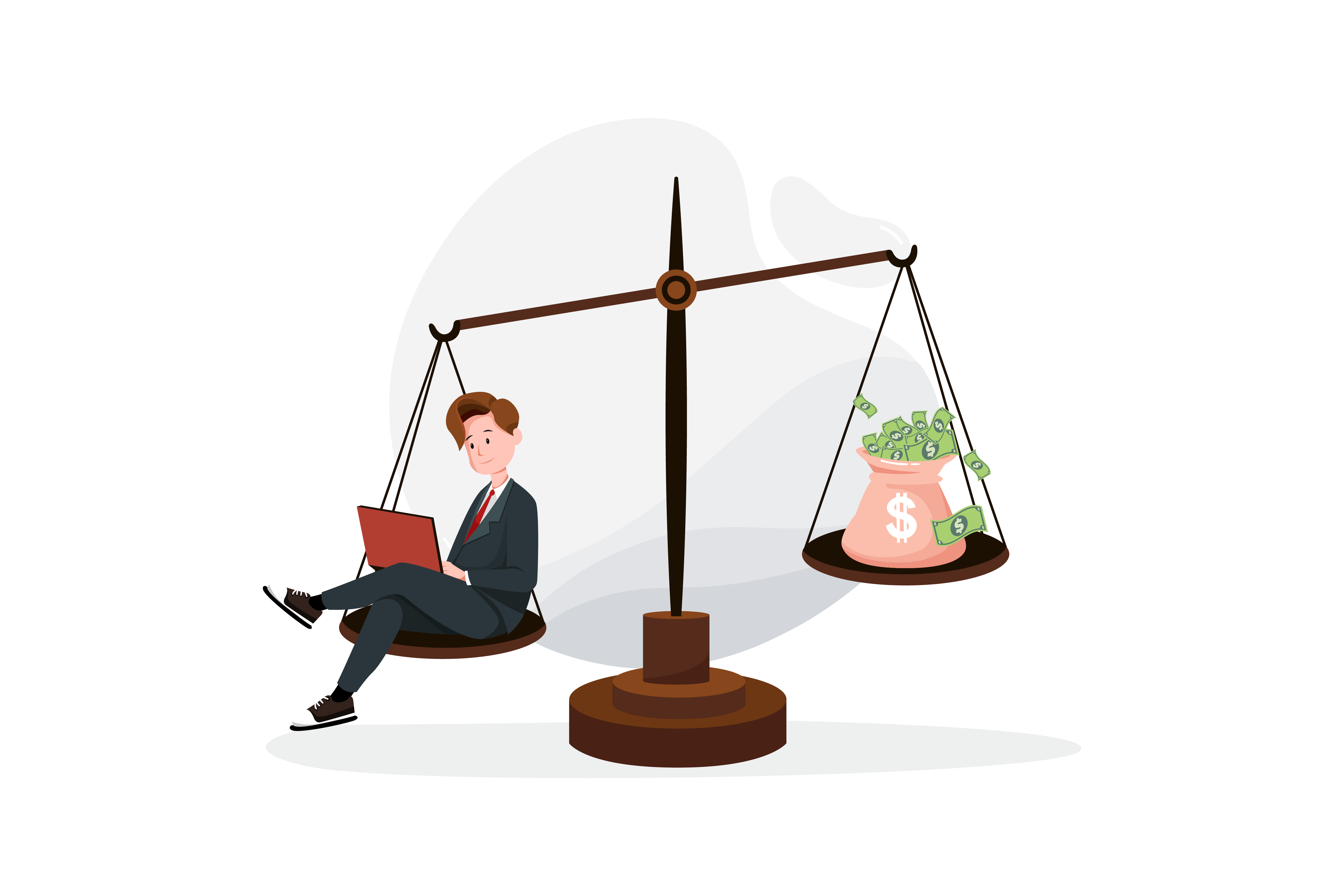
Striking the right balance between work, sleep, and leisure time can be challenging!
- CivicScience reports that, on average, 55% of Americans spend one to four hours watching TV daily, while 22% watch four or more hours each day.
- The majority of respondents (58%) indicated they'd prefer watching TV during the evening hours.
- On average, people in the US spend 4 hours and 30 minutes a day on mobile devices, and this is projected to increase to about 4 hours and 39 minutes by 2024.
- In 2022, Americans spent an average of 123 minutes per day using social media.
- Americans spend an average of 100 days per year online.

What's the only thing we love more than watching television? Playing with our smartphones.
☝
Did you know?
The perfect work-life balance would include eight hours of work, eight hours of sleep, and eight hours of leisure time (although this concept is slowly getting outdated).
But nothing is perfect.
The Organisation for Economic Cooperation and Development (
OECD) conducted a Better Life Index study which found that American workers typically spend 14.4 hours per week on sleep and leisure time. We’re already an hour and 20 minutes behind the perfect work-life balance!
Remote Work-Life Balance
During the pandemic and continuing afterward, remote work has emerged as a significant practice. The pandemic made lots of companies use remote work setups, showing it can work well and has good points.
This change lets employees work from home, which is good because they can be more flexible, have a better balance between work and life, and find a wider variety of skilled people.
Now, let's move on to the statistics related to remote work.
- Gartner estimates that by 2025, around 35% of all employees worldwide will work remotely, compared to 17% in 2019.
- In 2025, the US will have the most remote workers, making up nearly 60% of its workforce.
- In Europe, remote workers will account for 55% of the workforce in the UK, while Germany and France will have 45% and 40% remote workers, respectively
Share of Remote Workers of Total Employees, by Country (From 2019 to 2025)
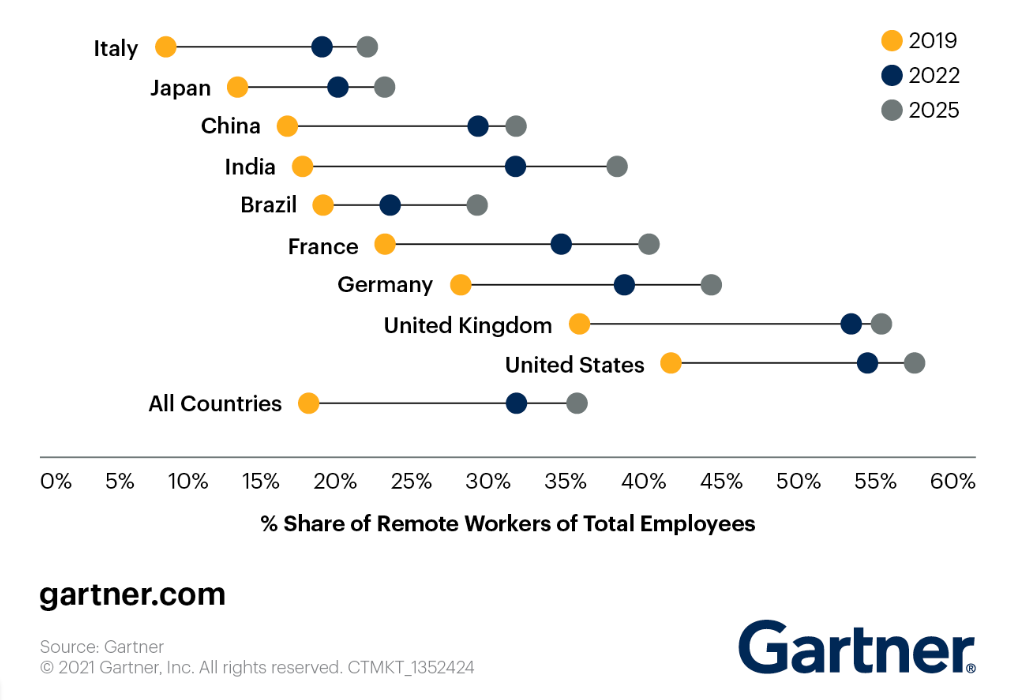
- People who work remotely or in a mix of remote and office settings feel just as connected to their bosses and the values of their company as those who work only in the office.
- Both higher-ups and regular employees like the idea of a mix between remote and office work. Around 65% of all workers prefer a balance between the two.
- The big bosses tend to prefer spending more time in the office, around 3 to 4 days a week.
- On the other hand, regular employees prefer more time working remotely.
- Regular employees are much more likely to want to work completely from home, almost three times more than their bosses.
Work-Life Balance of Americans During COVID-19
In 2022, Pew Research conducted a study showing big changes in remote work and attitudes among US workers during the COVID-19 pandemic.
- Around 59% of workers with jobs suitable for remote work were mainly working from home, which decreased from 71% in October 2020.
- However, this is still much more than the 23% who used to work from home often before the pandemic.
COVID's Impact on Work-Life Balance Among US Workers in 2022
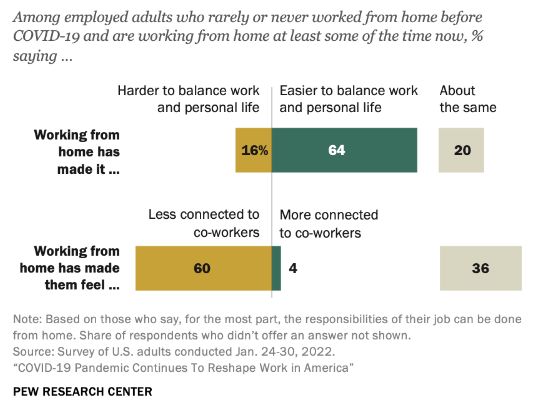
- 64% of workers found it easier to balance work and personal life when occasionally working from home.
- 44% of US workers reported increased productivity and better deadline management while telecommuting.
- Only 10% found remote work more challenging.
- 60% felt less connected to colleagues while working remotely.
- 72% believed telecommuting didn't impact their job advancement.
- 78% indicated their preference to continue remote work even after the pandemic.
Work-Life Balance of Americans After COVID-19
Here are the key points from the latest 2023 Pew Research Center Survey:
- Around 35% of remote-capable workers are currently working from home full-time, down from 43% in January 2022 and 55% in October 2020.
- About 41% of those with remote-capable jobs follow a hybrid schedule, combining remote work and office days. This is an increase from 35% in January 2022.
- Among workers who are remote all, most, or some of the time, 71% find remote work helps them balance their work and personal lives, with 52% saying it helps a lot.
- Roughly 12% of occasional remote workers believe it hurts their work-life balance, while 17% say it neither helps nor hurts.
Global Work-Life Balance: Country Insights
- In the 2023 Global Life-Work Balance Index, New Zealand takes the top spot with a score of 79.35, thanks to its strong economy and 32 days of annual leave, combined with its beautiful natural scenery.
- Spain scores 75.55, prioritizing life with a short work week, 36 days of annual leave, and visitor-friendly cities like Madrid, a remote work hub.
- France takes third place with a score of 75.34, showcasing a healthy life-work balance through its short average working week (25.6 hours), generous minimum wage, and innovative right-to-disconnect law.
- The United States ranks 53rd out of 60 countries due to limited annual leave, sick pay, and no universal healthcare system.
- Europe leads in life-work balance with 6 out of the top 10 and 12 out of the top 20 countries on the list.
- European nations like Finland, Denmark, Switzerland, the Netherlands, and Sweden are among the happiest.
- Australia and New Zealand have the highest minimum wages.
- Mexico, Malaysia, and Nigeria have the longest average workweeks, exceeding 40 hours each week.
Summary
In summary, work-life balance has evolved in response to remote work trends and pandemic challenges.
Prioritizing this balance yields benefits for well-being, productivity, and retention.
As we move forward, adjusting to new work styles while maintaining balance will be essential for thriving, ensuring a harmonious and fulfilling work-life combination.
Further Reading:
➜ Workplace Whirlwind: 63+ Jaw-Dropping Employee Engagement Statistics
➜ Hard To Believe Workplace Stress Statistics (US & Global)
Sources
UKG
OECD
EY
TheNextWeb
CompareCamp
Forbes
https://www.statista.com/statistics/215643/average...
https://www.statista.com/statistics/261808/monthly...
https://www.statista.com/statistics/1383762/burnou...
https://www.statista.com/statistics/1389778/nurses...
https://www.statista.com/statistics/1274617/indust...
https://futureforum.com/wp-content/uploads/2023/02...
https://futureforum.com/wp-content/uploads/2022/10...
https://civicscience.com/heres-what-watching-tv-lo...
https://www.eaglehillconsulting.com/insights/worke...
https://www.medscape.com/slideshow/2023-lifestyle-...
https://www.gartner.com/smarterwithgartner/hybrid-...
https://usblog.teamblind.com/wp-content/uploads/20...
https://www.businesswire.com/news/home/20220125005...
https://www.inflectionhr.com/hubfs/Collateral%20fo...
https://www.shrm.org/about-shrm/press-room/press-r...
https://www.pewresearch.org/social-trends/2022/02/...
https://www.pewresearch.org/social-trends/2023/03/...
https://remote.com/resources/research/global-life-...
https://www.athensnews.com/news/jobs-with-highest-...
https://www.glassdoor.com/blog/best-places-to-work...
 Calculating arrival date
Calculating arrival date









